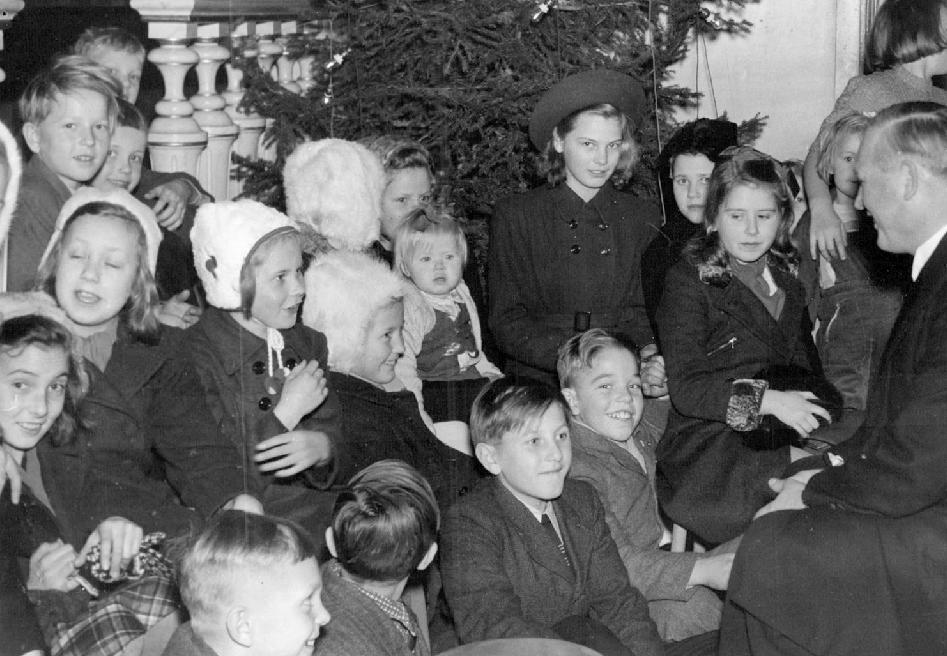
World War II Estonia: Minorities

Figure 1.-- Here Swedish-Estonian refugee children are enjoying a Christmas eve party at a church in Sweden after the War. As far as w know virtually none of the families rturned to Soviet occupied Estonia after the War. The Swedish press caption read, "Så här trivsamt hade några hundratal estlandssvenska barn ordnat för sig i Betesdakyrkan på söndagskvällen. Pastor Arthur Johansson (långst t. h.), som under många år verkat bland estlandssvenskarna på andra sidan Östersjön, har efter deras hitflyttning fortsatt detta hängivna arbete och samlat landsmännen till gudstjänst en gång i månaden till gudstjänst inleddes av pastor Johansson, varpå kyrkoherde B. Rydsttöm höll en kort betraktelse. Efteråt följde julfesten, varvid samtliga 500 deltagare bjöds på kaffe och alla barn fick julklappar." That transltes as something like, So this pleasant had a few hundred Estonian Swedish children arranged for themselves in Betesdakyrkan on Sunday evening. Pastor Arthur Johansson (long-time t. H.), who for many years appeared among Estonian Swedes on the other side of the Baltic Sea, has, after their hitflyttning, continued this dedicated work and gathered the compatriots to worship once a month to service was initiated by Pastor Johansson, whereupon vicar B. Rydsttöm kept a brief reflection. Afterwards followed the Christmas party, at which all 500 participants were treated to coffee and all children were given Christmas gifts." The photograph is dated Decembr 24, 1945.
|
|
We are unsure about the minority groups in Estonia at the time of World War II. Data exists on the current minorities. We are less sure about World War II. We believe that the major minority group was Russian as well as other Soviet groups (Ukranian and Belarusian), but there were also Finns, Swedes, Balts, Jews, and others. Estonians are related ethnically and lingustically to the Finns. There was an important German minority, but they were evacuated just before the War on Hitler's 'Home to the Reich' order. We do not have much information on these groups and their experience during the War. The relatively small Jewish population either fled east or were murdered by the Germans. We have found information on the ethnic Swedes in Estonia. The Soviet Union demanded Estonia sign a treaty allowing them to establish military bases on Estonian territory (1939). The Soviets made similar demands on Finland, Latvia, and Lithuania. The Finns fought leading to the Winter War (1939-40), the Balts acquiessed. The ethnic Swedes in Estonia mostly lived along the coast and offshore islands. Estonia was once part of the Swedish Kingdom. Gaining contol of these islands was an important Soviet goal meaning that the Swedes in Estonia were especially affected. Note that they were people of Swedish ancestry, but Estonian citizens. The Soviet military occupied many of these islands and built military instalations of various types. The inhabitats were forced out of their homes and off the islands. After the Soviets invaded Poland (September 1939), they moved against Estonia and the other two Baltic Republics annexing them to the Soviet Union. As far as we know, reltively few Estonian Swedes were able to flee to Sweden at this time. Estonia had been part of the Tsarist Empire. Thus there wer ethnic Russians in Estonia. The Soviets began moving more Russians into Estonia to improve the security situation. The Soviets alsobegan conscripting Estonian men, including the Swedish-Estonians, into the Red Army. After the Germans invaded (June 1941), the Germans conscripted men into the Wehrmacht. The Germansvery rapidly swept through the Baltics as part of Operation Barbarossa. With the German reverses in the East, the Red Army began to move toward the Baltics (1944). Most of the Estonian Swedes fled to Sweden at this time. The Germans do not appear to have prevented this nd began evacuating German civilins and wounded soldiers. At the end of the War, there were some 6,600 Estonian Swedes and 21,800 ethnic Estonian refugees in Sweden. [Zerterberg]
Sources
Zerterberg, Seppo. Viro, Historia, kansa, kulttuuri. (Helsinki: Suomalaisen kirjallisuuden seura, 1995).
CIH -- WW II

Navigate the CIH World War II Section:
[Return to Main World War II Estonian page ]
[Return to World War II Swedish refugees]
[Return to Main World War II country page ]
[Return to Main World War II displaced children page]
[Return to Main Estonian page]
[Biographies]
[Campaigns]
[Children]
[Countries]
[Deciding factors]
[Diplomacy]
[Geo-political crisis]
[Economics]
[Home front]
[Intelligence]
[POWs]
[Resistance]
[Race]
[Refugees]
[Technology]
[Bibliographies]
[Contributions]
[FAQs]
[Images]
[Links]
[Registration]
[Tools]
[Return to Main World War II page]
[Return to Main war essay page]
Created: 7:31 PM 2/14/2018
Last updated: 8:25 PM 2/14/2018



